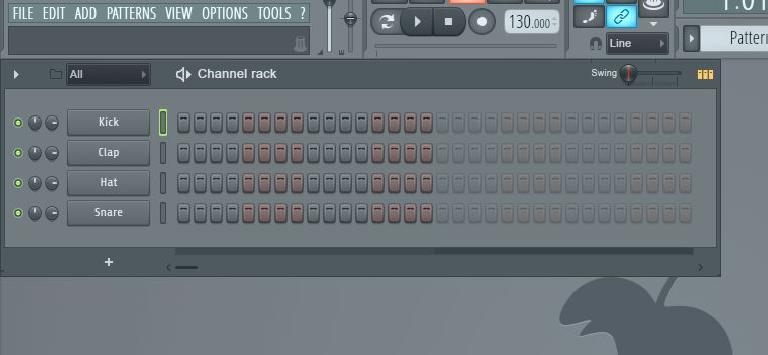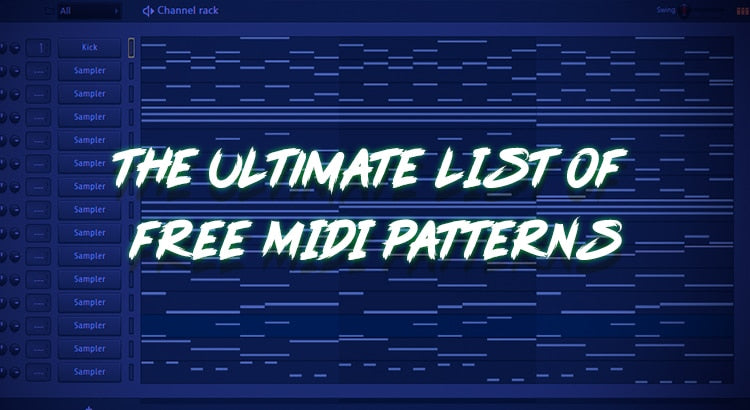

The more variation you add that’s outside of the traditional, western style of divisions of 4 or 8, you’ll get more complex rhythms that can bring life to your percussion or even your melodies. In the example above, I show each variation with a 4 step kick pattern, a snare looping with each beat, hi-hats looping throughout a bar, a tambourine looping in steps, a shaker looping an odd number of steps, and an additional percussive element looping in 12 steps. For example, you can have your kick looping every 4 steps like in house music, but have different percussive elements looping in different ranges.

That means you can create polyrhythms, like in African tribal music or other exotic rhythms, by setting each channel to loop beyond or before 4 by 4 sequences. With advanced looping, you can set each channel to loop per beat, bar, step or even a set number of steps to your liking. You can also burn all channels by right-clicking the arrow at the top of the channel rack and selecting “Burn All Looping Channels,” or just burn you selected channels with “Burn All Selected Channels”. This is handy for creating a looping pattern that you might want to switch up in the middle or at the end of pattern sequence for variation. Right-click that arrow and select burn to pattern to allow you to alter the loop throughout the pattern sequence. You’ll notice there is a green arrow, identical to the arrow at the top of the channel rack that is located at the end of each channel sequence. Now the channels will loop the steps and piano roll sequences you create continuously throughout the entire length of the pattern.

Set the desired length of the entire pattern at the top right of the channel rack toolbar, next to the swing knob. To use traditional channel looping that was available in version 11, simply choose loop all channels. Advanced looping will bring up an additional option to allow you to set individual loop lengths, located at the end of each channel sequence in the channel rack. Looping all channels will also include looping from channels using the piano roll. Looping step channels will only loop the channels that use the step sequencer. When you right-click the arrow, it will now give you the option to loop step channels, loop all channels, or switch to advanced looping. It will turn green when you switch it on. To turn channel looping on, click the arrow at the top left of the channel rack toolbar.
FL STUDIO SWING NOTES PLUS
Well, now that it’s back in version 20.1, it has been upgraded with a few new features that will allow the previous functionality, plus the ability to create polyrhythms inside of a single pattern.

Typically, this was a faster workflow because you could quickly make 4 or 8 bar drums loops and in addition, add your 8 or 16 bar chord progressions, melodies and basslines inside the same pattern without switching to a new pattern and adjusting the pattern length or creating an arrangement in the Playlist to loop the shorter patterns with the longer ones. With channel looping, you could make an entire project inside of a single pattern and later use “Split By Channels” to separate them at the end to arrange in the Playlist. This left a lot of users wanting to stick with version 11, mainly because of the style of workflow this allowed for inside of the channel rack. Channel looping was unfortunately taken away when the new GUI from version 12 was introduced. In this instance, I will be using Serum as the VST however, this technique will work with any plugin with an adjustable pitch parameter.One of the most important features added to FL Studio 20.1, was actually a previous feature in FL Studio 11. Pitch Bend Using Automation Clipsįor pitch-bending audio coming from a third-party VST, we will be utilizing the automation clip feature within FL Studio.
FL STUDIO SWING NOTES HOW TO
I’ll explain how to pitch bend audio coming directly from VST’s and audio samples with FL studio’s built-in tool, which can be accessed through the piano roll. In this article, we will be looking into how it can be achieved specifically inside of FL Studio, regardless of the situation you want to use it in. Pitch bending has become an essential tool in modern music production, with many artists utilizing it to great effect. If you are instead using audio, you can use FL studio’s built-in pitch bend function from the piano roll. If you are working with a plugin, you can create an automation clip of the VSTs pitch parameter. When it comes to how to pitch bend in FL Studio, there are two main methods depending on the audio source.


 0 kommentar(er)
0 kommentar(er)
